Crow
Silver Member
- Joined
- Jan 28, 2005
- Messages
- 4,022
- Reaction score
- 11,190
- Golden Thread
- 0
- Location
- In a tax haven some where
- Detector(s) used
- ONES THAT GO BEEP! :-)
- Primary Interest:
- Other
- #1
Thread Owner
Hello it seems I am under duress as I have been threatened with walking the plank and eating Don Jose's marry ki ki.
Another yarn before I haul away Joe.. An excellent working sea shanty hauling up the sails. Even the girls get into singing it as it is an excellent working song for team work.
You know there is a slight injustice that comes with people perception of native cultures in Peru. And that is the obsession with Inca treasure. in fact the Incas were the johnny come lately onto the scene however fascinating they are. There are other cultures in Peru just as fascinating. There are several cultures in Peru that was just as rich in treasure than the Incas if not more.
The following story some of you will perhaps see similar story versions elsewhere?
The following Newspaper story The Kalgoolie miner dated 9th October 1948.
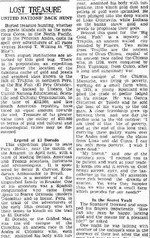
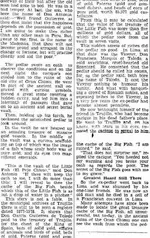
UNITED NATIONS' BACK HUNT
Buried treasure hunting, whether on pirate islands such as the notorious Cocos, in the North Pacific, or in the Peruvian Andes, casts its spell over adventurers of all races (writes Harold T. Wilkins in 'Tit Bits'). Even august institutions are at tacked by this gold bug. There is in preparation an expedition to discover the location of the fabulous cache of gold and jewels and gemmed idols known to the
folk of Trujillo, in northern Peru, as the Big Fish (El Peje Grande). It is backed by Unesco, the United Nations Educational, Scientific and Cultural Organisation, to the tune of £12,500, and five South American republics have voted an equal amount towards the cost. Treasure of far greater value than the outlay of £25.000 in terms of gold and cultural and achaeological values may be dis covered Legend of Eldorado This expedition plans to leave Para, near the mouth of the Amazon, in April next, with a team of leading British, American and French scientists, historians and archaeologists. It is sponsored by Senor B. Carrion, Ecuadorian Ambassador to Brazil. Carrion is a member of a distinguished family in Ecuador. One of his ancestors was a Spanish conquistador who came from Spain to Nueva Granada (modern Colombia) and to Incaic, Peru, in the train of the adventurers of the early 16th century who left their bones to bleach on the trail to El Eldorado. El Eldorado, or the Gilded Man, was the old cacique of the Chibchas, an ancient race in the Andes of Colombia who, each year, anointed his body with turpentine, into which gold dust and pellets of gold were sprinkled. He then plunged into the deep waters of Lake Guaravita, while Indians on the banks threw gold and jewels to propitiate their gods.
Behind this quest for the 'Big Gold Fish' is a mystery of Trujillo, an ancient walled city founded by Pizarro. Two miles from Trujillo are the ancient ruins of Gran Chimu, capital of an ancient race called the Chinius who, in 1378, were conquered by Inca Yupanqui, from Cuzco, after a long and sanguinary war. The cacique of the Chimus. Mansiche, was living in poverty, working on a small farm when, in 1575, a young Spaniard who plied the trade of pedlar lodged at his cottage. He was Garcia Gutierrez de Toledo and .he sold the best of his wares to the old man. A close friendship grew up between them and one day the pedlar said to the old cacique: 'I am tired of this life of poverty, and at the end of this long trail, carrying these paltry wares over the Andes and across the plains from Lima and old Cuzco, I can see only more poverty. I wish I were dead..' 'My friend,' said one of -the cacique's sons, 'I counsel you to be patient and work at your trade. It keeps you and it serves us. Gold brings sorrow, envy, and the tax collector in its train. My ancestors were rich, beyond the dreams of avarice. Yet were they happier than we who work a small farm which provides for. our needs?'
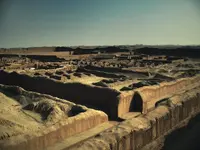
In the Secret Vault The Spaniard frowned and snapped his fingers impatiently. 'How can any man be happy, lacking gold and the means for a pleasant life?' he asked. One night he was talking with another of the cacique's sons in the doorway of their hut after the old man had gone to bed. He was in a bad temper. At last, the son, who bore the name of Don Antonio, said:— 'Well friend Gutierrez, as thou dost insist that thy happiness depends on the possession of gold, I am going to make thee richer than any other man in Peru. But, swear to me, first, in the name of the Madonna, that -thou wilt not become proud and arrogant in thy change oi fortune, but will practise charity and aid the poor.' The pedlar swore an oath to observe the conditions and on the next 'night the cacique's son guided him to the ruins of the old city of Gran Chimu. He went to part of the ancient wall en graved with curious symbols, moved a great stone covering a hidden cavity, and led him into a labyrinth of passages that gave on to an ancient and secret burial vault. Then, holding up his torch, he beckoned the astonished pedlar to look around.
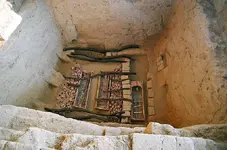
In the vault he saw heaped up an amazing treasure of massive gold vessels. In the middle of the vault was a curious scaffolding on top of which was the image of a fish whose scaly body was of pure gold, and its eyes two magnificent emeralds. 'This is the vault of the Little Fish (El Peje Chico),' said Don Antonio. 'If thou wilt keep thy oath to me, I will do more than this: 1 will reveal to thee the cache of the Big Fish, beside which this of the Little Fish is as 'out a drop of water in a pitcher.' This story is not a fable. In the municipal archives of Trujillo there is still to be seen a register dated 1577-1578. It shows that Don Garcia Gutierrez de Toledo paid to the treasury of Trujillo, for the chest of the King of Spain, bars of solid gold, effigies of animals and birds of gold, bells of gold, Pateras (gold and gem med dishes), and heads of corn of pure gold, worth 85,577 gold cas tellanos From this it may be calculated that the value of the treasure of the Little Fish was more than five millions of gold dollars, all of which the pedlar took from the vault in seven visits.
This sudden access of riches did the pedlar no good, in Lima, at that date, was the Viceroy, Don Francisco. Marquis of Toledo, a cold avaricious, cruel-hearted old Spaniard. He consented that the pedlar should be called his cousin, for, as the pedlar said, both bore the name of Toledo. It cost the Viceroy nothing to humour his vanity. And what with banqueting a crowd of Spanish nobles, and repeated bribes to the Viceroy, in a very few years the ex-pedlar had become almost penniless. He now bethought himself of the friend in Trujillo, who had become cacique in his dead father's place. He went to Trujillo and, on his knees, with tears in his eyes, I need the cache of the Big Fish. 'I am ruined,' he said. 'That does not surprise me,' re plied the cacique. 'You heeded not my warning and you broke your oath as regards the poor. The secret of the Big Fish goes with me to my grave.' Greatest Hoard Still There So the ex-pedlar went back to Lima and was shunned by his one-time friends. He was now an old man and he died in a cell of a Franciscan convent in Lima Many attempts, have since been made to locate the' great treasure cache of the Big Fish, all unsuccessful, but to-day, in the ancient ruins of the Gran Chimu one can see the vault from which the pedlar took the treasure. of the Little Fish.
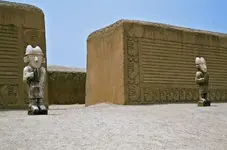
At one time, in the 18th century, the Spanish authorities thought they were on the trail of the Big Fish. A cacique, Don Antonio Chayque, offered to reveal the cache if the chief alcalde in Lima would give him money for the Indians By a town tax the Spaniards raised 42,187 dollars, but little reached the Indians, though some treasure was found. The vast Big Fish treasure, however, remains undiscovered; will this new £25,000 expedition unearth it at long last?
Is there still treasure still there today lost somewhere in the ruins of Chan Chan.
Perhaps perhaps not?
crow
Another yarn before I haul away Joe.. An excellent working sea shanty hauling up the sails. Even the girls get into singing it as it is an excellent working song for team work.
You know there is a slight injustice that comes with people perception of native cultures in Peru. And that is the obsession with Inca treasure. in fact the Incas were the johnny come lately onto the scene however fascinating they are. There are other cultures in Peru just as fascinating. There are several cultures in Peru that was just as rich in treasure than the Incas if not more.
The following story some of you will perhaps see similar story versions elsewhere?
The following Newspaper story The Kalgoolie miner dated 9th October 1948.


UNITED NATIONS' BACK HUNT
Buried treasure hunting, whether on pirate islands such as the notorious Cocos, in the North Pacific, or in the Peruvian Andes, casts its spell over adventurers of all races (writes Harold T. Wilkins in 'Tit Bits'). Even august institutions are at tacked by this gold bug. There is in preparation an expedition to discover the location of the fabulous cache of gold and jewels and gemmed idols known to the
folk of Trujillo, in northern Peru, as the Big Fish (El Peje Grande). It is backed by Unesco, the United Nations Educational, Scientific and Cultural Organisation, to the tune of £12,500, and five South American republics have voted an equal amount towards the cost. Treasure of far greater value than the outlay of £25.000 in terms of gold and cultural and achaeological values may be dis covered Legend of Eldorado This expedition plans to leave Para, near the mouth of the Amazon, in April next, with a team of leading British, American and French scientists, historians and archaeologists. It is sponsored by Senor B. Carrion, Ecuadorian Ambassador to Brazil. Carrion is a member of a distinguished family in Ecuador. One of his ancestors was a Spanish conquistador who came from Spain to Nueva Granada (modern Colombia) and to Incaic, Peru, in the train of the adventurers of the early 16th century who left their bones to bleach on the trail to El Eldorado. El Eldorado, or the Gilded Man, was the old cacique of the Chibchas, an ancient race in the Andes of Colombia who, each year, anointed his body with turpentine, into which gold dust and pellets of gold were sprinkled. He then plunged into the deep waters of Lake Guaravita, while Indians on the banks threw gold and jewels to propitiate their gods.
Behind this quest for the 'Big Gold Fish' is a mystery of Trujillo, an ancient walled city founded by Pizarro. Two miles from Trujillo are the ancient ruins of Gran Chimu, capital of an ancient race called the Chinius who, in 1378, were conquered by Inca Yupanqui, from Cuzco, after a long and sanguinary war. The cacique of the Chimus. Mansiche, was living in poverty, working on a small farm when, in 1575, a young Spaniard who plied the trade of pedlar lodged at his cottage. He was Garcia Gutierrez de Toledo and .he sold the best of his wares to the old man. A close friendship grew up between them and one day the pedlar said to the old cacique: 'I am tired of this life of poverty, and at the end of this long trail, carrying these paltry wares over the Andes and across the plains from Lima and old Cuzco, I can see only more poverty. I wish I were dead..' 'My friend,' said one of -the cacique's sons, 'I counsel you to be patient and work at your trade. It keeps you and it serves us. Gold brings sorrow, envy, and the tax collector in its train. My ancestors were rich, beyond the dreams of avarice. Yet were they happier than we who work a small farm which provides for. our needs?'

In the Secret Vault The Spaniard frowned and snapped his fingers impatiently. 'How can any man be happy, lacking gold and the means for a pleasant life?' he asked. One night he was talking with another of the cacique's sons in the doorway of their hut after the old man had gone to bed. He was in a bad temper. At last, the son, who bore the name of Don Antonio, said:— 'Well friend Gutierrez, as thou dost insist that thy happiness depends on the possession of gold, I am going to make thee richer than any other man in Peru. But, swear to me, first, in the name of the Madonna, that -thou wilt not become proud and arrogant in thy change oi fortune, but will practise charity and aid the poor.' The pedlar swore an oath to observe the conditions and on the next 'night the cacique's son guided him to the ruins of the old city of Gran Chimu. He went to part of the ancient wall en graved with curious symbols, moved a great stone covering a hidden cavity, and led him into a labyrinth of passages that gave on to an ancient and secret burial vault. Then, holding up his torch, he beckoned the astonished pedlar to look around.

In the vault he saw heaped up an amazing treasure of massive gold vessels. In the middle of the vault was a curious scaffolding on top of which was the image of a fish whose scaly body was of pure gold, and its eyes two magnificent emeralds. 'This is the vault of the Little Fish (El Peje Chico),' said Don Antonio. 'If thou wilt keep thy oath to me, I will do more than this: 1 will reveal to thee the cache of the Big Fish, beside which this of the Little Fish is as 'out a drop of water in a pitcher.' This story is not a fable. In the municipal archives of Trujillo there is still to be seen a register dated 1577-1578. It shows that Don Garcia Gutierrez de Toledo paid to the treasury of Trujillo, for the chest of the King of Spain, bars of solid gold, effigies of animals and birds of gold, bells of gold, Pateras (gold and gem med dishes), and heads of corn of pure gold, worth 85,577 gold cas tellanos From this it may be calculated that the value of the treasure of the Little Fish was more than five millions of gold dollars, all of which the pedlar took from the vault in seven visits.
This sudden access of riches did the pedlar no good, in Lima, at that date, was the Viceroy, Don Francisco. Marquis of Toledo, a cold avaricious, cruel-hearted old Spaniard. He consented that the pedlar should be called his cousin, for, as the pedlar said, both bore the name of Toledo. It cost the Viceroy nothing to humour his vanity. And what with banqueting a crowd of Spanish nobles, and repeated bribes to the Viceroy, in a very few years the ex-pedlar had become almost penniless. He now bethought himself of the friend in Trujillo, who had become cacique in his dead father's place. He went to Trujillo and, on his knees, with tears in his eyes, I need the cache of the Big Fish. 'I am ruined,' he said. 'That does not surprise me,' re plied the cacique. 'You heeded not my warning and you broke your oath as regards the poor. The secret of the Big Fish goes with me to my grave.' Greatest Hoard Still There So the ex-pedlar went back to Lima and was shunned by his one-time friends. He was now an old man and he died in a cell of a Franciscan convent in Lima Many attempts, have since been made to locate the' great treasure cache of the Big Fish, all unsuccessful, but to-day, in the ancient ruins of the Gran Chimu one can see the vault from which the pedlar took the treasure. of the Little Fish.

At one time, in the 18th century, the Spanish authorities thought they were on the trail of the Big Fish. A cacique, Don Antonio Chayque, offered to reveal the cache if the chief alcalde in Lima would give him money for the Indians By a town tax the Spaniards raised 42,187 dollars, but little reached the Indians, though some treasure was found. The vast Big Fish treasure, however, remains undiscovered; will this new £25,000 expedition unearth it at long last?
Is there still treasure still there today lost somewhere in the ruins of Chan Chan.
Perhaps perhaps not?
crow
Last edited:



 I agree on all counts, Crow has mastered the art of accomplishing his goal without working for it, I often wonder how many indiscreet pats he has done on this voyage alone. Sigh,. imagine lying on yer tummy on the foredeck of the Drumbeat getting your back and neck worked on by scantily clad Polynesian lovelies ?
I agree on all counts, Crow has mastered the art of accomplishing his goal without working for it, I often wonder how many indiscreet pats he has done on this voyage alone. Sigh,. imagine lying on yer tummy on the foredeck of the Drumbeat getting your back and neck worked on by scantily clad Polynesian lovelies ? 



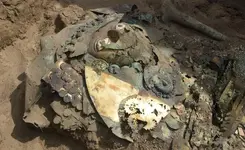
 for that
for that
